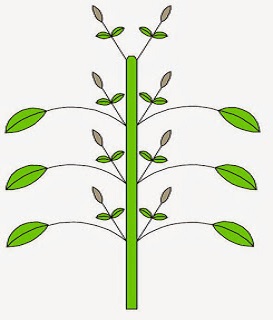Blog - Understanding Pruning
Pruning is not such a dark art...
There have been lots of books written on the subject of pruning and none of them are short. Perhaps this is why it is considered to be an expert's job and not something which any gardener can face with confidence. There are seemingly 10's if not 100's of rules to be followed before you may dare to pick up your secateurs and venture into the garden.
Actually, pruning is not a dark art at all and can be tackled by everyone once a few basic rules are understood. So here's the theory...
Looking
It's important to take a good look at any plant you intend to prune and to appreciate its natural shape before you start cutting. I have seen many instances of a wide range of shrubs being pruned into the same shapes, regardless of their natural habits. What you end up with is a collection of different sized 'pudding' plants!
Timing - knowing when to prune
- Roses should be pruned in the dormant season, ie. winter
- Pip fruit (apples and pears) should also be pruned in winter
- Deciduous shrubs - it depends when they flower (see below)
- Evergreen shrubs are generally best pruned in spring since pruning in the autumn going into winter or during winter will leave them exposed to frost damage
- Wisteria should be pruned twice a year, once in winter (February) and once in summer (July).
Pruning Formula
- Take a good look at the shape of the plant before you start
- When you do start, work from the bottom to the top
- Remove the 4 D's - Dead, Diseased, Damaged and Decrepit
- Remove stems which are crossing
Botany
A plant wants to grow upwards, generally speaking. If its growing tip or apical bud is removed, the buds waiting in the leaf axils, known as the axillary buds will be stimulated into growth.


The basic principle of pruning is that by removing material, the gardener can simultaneously reduce growth and induce new growth where and when it is wanted, varying the direction, quantity and vigour of this growth as desired.
Tools
The 3 tools you will need for successful pruning are a pair of sharp secateurs (Felco or Okatsune are good), some loppers (I use a Darlac handy ratchet lopper because it's light and cuts anything up to 35mm diameter) and a pruning saw for larger branches.
Keep your secateurs sharp using a Felco sharpening stone (about £20 on ebay but worth the investment) and clean the blades of your tools regularly using methylated spirit.
Cutting correctly

Taking roses as an example - to promote growth in the right direction you need to cut to an outward facing bud, that is a bud which is on the outside of a stem rather than on the inside of a stem. The resulting new growth will then grow outwards and not inwards, making the plant open rather than closed and congested in the middle.
- correct slope - not too sloping and not too flat;
- correct height - not too close and not too far away from the bud;
- sloped away from the outward facing bud so that water drains away.
Feeding
It's important to feed a plant after pruning. Use a balanced fertiliser, with an equal ratio of N (Nitrogen, for leaf growth), P (Phosphorus for root growth) and K (Potassium for flower production). Look at the fertiliser packet, where you will see a figure given in the form N:P:K - the numbers corresponding to N, P and K need to be roughly equal.
So now you know the theory, what about the practise....?
Roses
There are many different types of rose, but the basic theory behind their pruning is the same and as described above. So, to recap:
The time to prune roses is during the winter, when they are dormant. February is a good time. Look at the shape of the plant before you start. Pruning promotes growth so this is your opportunity to make a more balanced and beautiful plant, whilst appreciating the rose's natural shape.
Working from the bottom to the top of the plant, firstly remove the 4Ds - the Dead, Diseased, Damaged and Decrepit stems (these will be easily recognisable by the fact that they will be brownish in colour and not bright green healthy, new growth). Next remove any Crossing stems. The objective is to create an open centre to the rose bush to take advantage of as much light as possible, to create a pleasing shape and to promote air circulation (thus avoiding mildew).
If your rose is a Hybrid Tea rose (you can recognise this type of rose since it has the type of flower you would receive in a bouquet for Valentine's day on a long straight stem), it will grow 3-4 feet in a season so needs to be cut down by about 3/4 so that flowers do not appear too high up on the plant.
If your rose is a repeat-flowering English Rose (such as those bred by David Austin) then its shape is important and it should generally be cut down by about 1/3.
If your rose is a once flowering rambling rose it will send out long rod like growth after flowering. These are the flowering stems for the following year and can be tied in, bending the shoots downwards as you do so to break apical dominance and to encourage more axillary buds to produce flowering shoots (see Botany section above). Old flowering stems can be cut back hard. Essentially, this can be done in late summer after flowering or left until February when other rose pruning is done. The advantage of pruning ramblers immediately after flowering is that the new long stems can be tied in and not blown about by the wind.
See the Peter Beales Blog section on Pruning for some more useful information on other types of rose pruning:
Pip Fruit
Pruning should be carried out during winter - again, February is a good time. The object of pruning an apple or pear tree is to create a framework of between 3 and 5 main branches, evenly spaced around the tree. The end result should be a wide, open-centred tree (through which a hat could be thrown is the old rule!) to allow for good air circulation.
The same principles of looking at the tree's shape, removing the 4Ds and crossing branches still applies, as does working from the bottom to the top.
Once the basic branch framework is created, last year's new, long growth (laterals) can be cut back to 2 or 3 buds. As this action is performed year after year, the number of fruit buds in one location will increase, giving rise to spur systems, which are simply groups of fruit buds. As the tree grows older, these spur systems themselves become congested and will need thinning.
With fruit trees, it is not a good idea to overprune since new growth will be produced at the expense of new fruit buds. A balance between new growth and new fruiting growth needs to be achieved by judicious pruning.
Shrubs
Early flowering shrubs such as Forsythia or Philadelphus flower in early spring on the growth made last year, so they need to be pruned immediately after flowering in order to make enough growth on which to flower the following spring. If these shrubs are left unpruned and then pruned in spring before flowering, no flowers will be produced that year.
The saying "If it flowers before June, don't prune" actually means don't prune it until after it has flowered!
Later flowering shrubs such as Buddleja or Fuchsia flower from July onwards on the current year's new growth. It is best to prune them in early spring - February is a good time - just as they are coming into growth. This will give them a long season to put on new growth ready for flowering later in the year. Pruning them in the middle of winter is not advisable since they may suffer from dieback caused by frost damage.
Wisteria
Pruning Wisteria is a 2 step process:
- In summer after it has flowered at the end of July or beginning of August, the whippy extension growth should be cut back to 4-6 buds.
- In winter (February) the same growth should be further cut back to 2-3 buds to encourage the plant to put all its energy into creating flowering spurs
I am grateful to Anne Tweddle of The Pruning Company for her informative talk on pruning which prompted this blog. Anne will visit your garden to carry out your pruning or to coach you if you want to develop the confidence to have a go yourself.
For further detailed information on pruning, I can also thoroughly recommend the RHS manual "Pruning and Training" by Christopher Brickell and David Joyce.
Angela Tolputt - 21st Jan 2014






